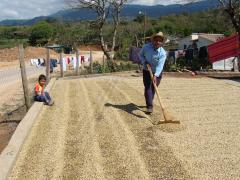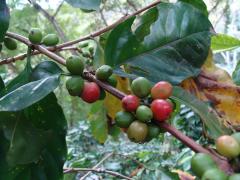Coffee Harvest
The areas we've been riding through on Guatemala and Honduras are all full-bore into the coffee harvest. Coffee is everywhere, and it's really interesting to see where that brew comes from.
On the picking side, we've met little kids with mayonaise jars and whole families, each with a home-made bucket. They work as hired hands, getting paid about 1 lempira, or 2 cents per pound of picked coffee. A family can pick a fair bit in a day - maybe each of the kids can pick 40 pounds, bringing in US$2.00. This time of the harvest can be the primary cash earning time of many of these campesino families.
We met Carlos, on the complete upper end of the coffee spectrum, at a hot spring in Gracias, Lempira, Honduras. He is a coffee taster, employed by the Guatemalan national coffee testing laboratory, and he helped us understand some of the details about the harvest. He mentioned that US people have a tendency to disapprove of small children being involved in the coffe harvest, but here it's a longstanding tradition, and beneficial to the families. Carlos also explained what makes coffee good (bigger beans, shade grown, mountains, etc.) and what the various grades of coffee are, and how world price fluctuations affect this region (a lot!)The coffee bean off the bush is a largish green thing, which has to have the outer fleshy part ripped off with a machine to leave the inner bean. This step of the harvest is invariably done with a machine. Then the coffee is left out in the sun for three days to dry. We see drying coffee everywhere we go. Sometimes it's on a concrete platform that looks like it's made for the drying, and sometimes it's just out on a plastic sheet by the road.
After it's dry, the grower takes it to a buyer or a cooperative, and somewhere along the way the base price is $1.35 or so a pound right now. That's the international base price. From talking with some of the small farmers along the way, we gather that they get about $1.00 of that for their finished beans.
Then, of course, at some point the coffee is roasted and packaged and you get to drink it at Starbucks. It sure is big business. We did hear about one cooperative of indigenous people in the northern area of Nebaj, Guatemala, who control the whole process, packaging and shipping their own brand of roasted and ground coffee directly to Italy. Their Italian priest helped make the arrangements after people started moving back into the region after the civil war calmed down in the 90's.


